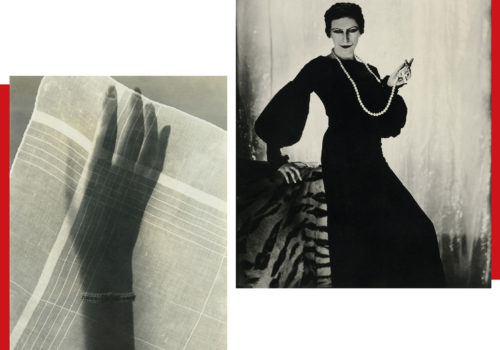This is the eighth Dialogue of the Ettore Molinario Collection. A dialogue that comes from the pleasure to be able to gather at Paris Photo and once again feeling the power of photography. We juxtapose a portrait of Cecil Beaton, which became part of the collection a few days ago, and a small masterpiece by an anonymous author that had been waiting for its right partner for many years. I invite you to discover «a certain something» that unites the two images and to follow us on our next appointments.
Ettore Molinario
If we had a movie camera, we would start with that hand of a Madonna and model that holds an ivory cross and shows it between the very thin fingers like the relic of a joyful sin. From the palm raised to the sky we would climb along the beads of the rosary, we would caress that girl’s neck and that scarlet smile that goes beyond her mouth and promises wonders. Even the eyes say so, in the mascara darkness that lets only the blue star of the iris shine: «enter the game». And the other hand also says so as it descends to the ground, towards her passions, and rests confidently on a tiger skin. If we had a camera, we would ask Cecil Beaton to continue the film, to play again and walk towards us, weaving into the extremely refined and cruel feminine that inhabits him.
This is how the great photographer appeared at Elsa Maxwell’s birthday party in Paris in 1930. After all, how could he have celebrated the power of one of the most poisonous and two-pronged pens in journalism of the time? How to flatter that woman who loved women and decided the fate of anyone who aspired to success? As a gift to Maxwell, Beaton had offered another woman, the mother of all strong females, the tiger and the lady of bon ton, and had therefore worn the clothes of Elinor Glyn, English writer, screenwriter, producer and director, so confident of oneself to recognise and cast the talent of others. And the others were Rodolfo Valentino, Gloria Swanson, Clara Bow, all happy owners of «a certain something», or simply «it» as Glyn called it.
Posing en travesti in front of George Hoyningen-Huene’s lens, Cecil Beaton declared his particular version of «a certain something», that makes people different because they are stronger and more complete. And Beaton’s «it» was the power to speak to opposites, to the heaven of the saints and the land of temptations, to the feminine in the masculine and to the masculine in the feminine, letting the body, in the black velvet that guards it, reveal them both. In the mystery of his anonymity, another photographer had come to the same radiant conclusions and in the same years, in Paris, had played between positive and negative, and he too had seen a woman’s hand emerge through the faint stripes of a man’s handkerchief.
Ettore Molinario
















